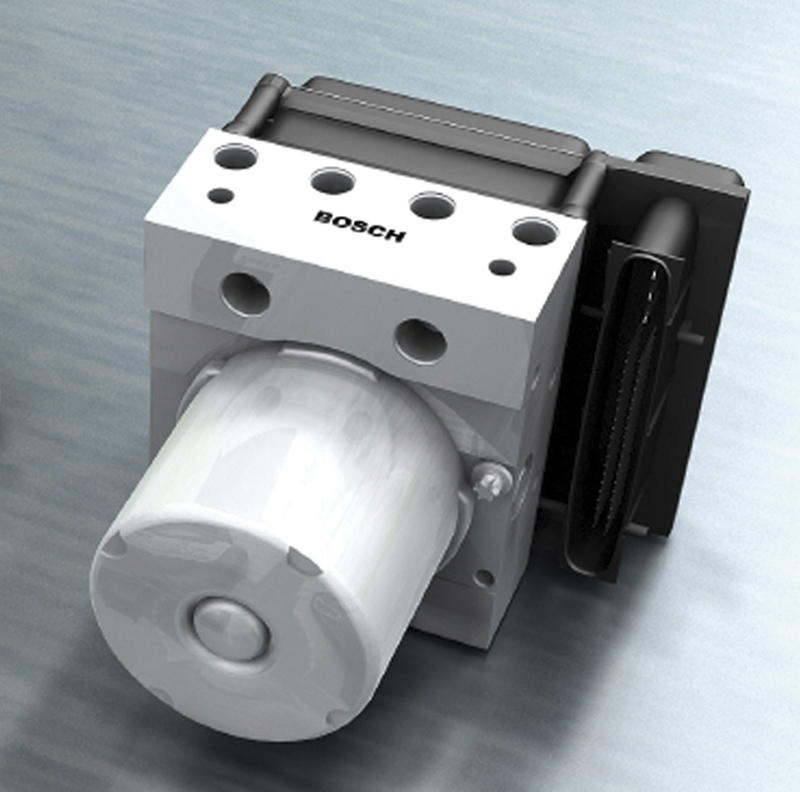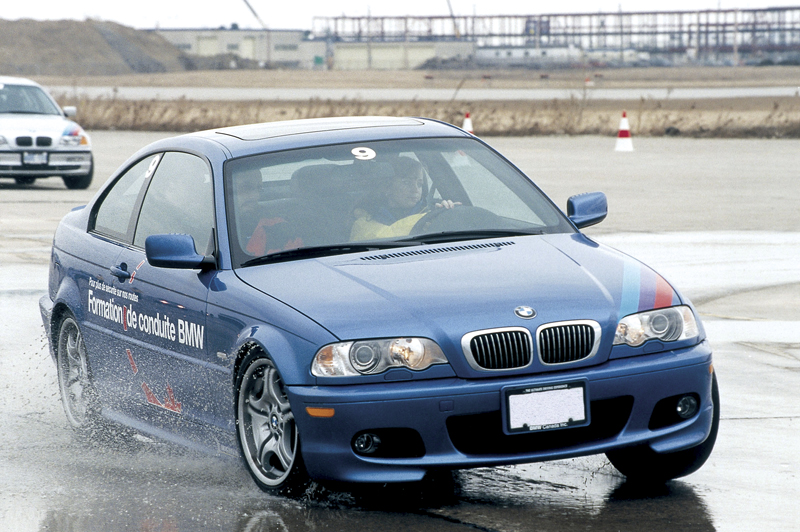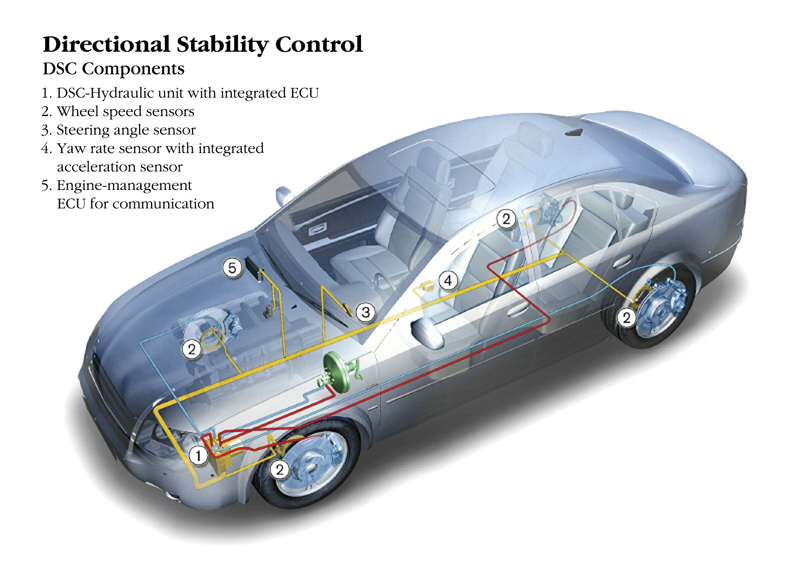
You cut the wheels to the right—too much, too fast, and the rear end begins to swing out. But as quickly as the rear starts to move, the car stabilizes. Instead of spinning out, the rear end stops moving, tucks back into place, and you continue driving as if nothing happened.
Did your guardian angel suddenly take control of the car and maneuver you out of danger? Well, sort of. But this guardian angel isn’t spiritual, it is man-made. You have just experienced BMW’s Dynamic Stability Control (DSC) system in action. The technology continuously monitors the vehicle’s position as it travels down the road and immediately corrects potentially dangerous understeer and oversteer by selectively regulating braking force to individual wheels and reducing engine speed.
Most of the time on the highway, vehicle speeds are slow enough, and road conditions are good enough, that it is relatively easy to control a car, especially a BMW. However, when the combination of speed, road conditions, and steering wheel input causes the tires to lose their grip, understeer or oversteer can occur. With understeer, the vehicle slides toward the outside of the curve. With oversteer, the back end comes around and could put the vehicle into a complete spin.

DSC works in conjunction with ABS, with which it shares the hydraulic control unit (courtesy Bosch).
Without training, most drivers don’t recognize potential out-of-control situations early enough to do anything to avert disaster. And when a car does go into a serious understeer or oversteer condition, the typical reaction is to slam on the brakes and hope you don’t hit anything. With DSC, the driver doesn’t have to recognize and respond to possible out of control situations because the system will do that automatically.
First introduced on certain models in 1995, DSC is now standard on all BMWs. One experience with DSC and you understand why the National Highway Traffic Safety Administration (NHTSA) has taken the first steps toward making stability control mandatory on all new cars, SUVs, and light trucks. Although BMW’s DSC and similar technology used by other carmakers has been on the street in significant numbers for only a few years, the impact on reducing crashes, deaths, and injuries has been dramatic. Based on studies of stability control’s effectiveness, NHTSA says that if all cars, light trucks and SUVs had such a system, up to 40% of the nearly two million single-vehicle crashes that now occur in the United States every year might be prevented.
One reason stability control is such an effective safety technology is that, unlike seat belts, airbags, crash/crumple zones, and similar systems, DSC is pro-active. Other safety devices come into play when a crash occurs. DSC helps prevent some crashes from happening in the first place.
ABS, AST, and DSC
DSC is built on the foundation established by anti-lock brake and all season traction (ABS and AST) systems. ABS and AST essentially keep a BMW pointed straight ahead by eliminating both wheel lockup or wheel spin that can cause unintentional swerving. DSC is the next step in control, helping to stabilize the vehicle as the driver makes a turn, especially at high speeds.

No matter how many driving schools a motorist might attend, he or she will never be able to make the kind of corrections that DSC does automatically and instantaneously.
Just as ABS “pumps†the brakes to prevent wheel lockup faster than any human being ever could, DSC corrects loss of control by electronically “turning into a skid†more effectively than is humanly possible. The stability system is so fast, it corrects problems before many drivers even realize they are on the verge of losing control, especially when road conditions are poor because of rain, snow, ice, etc.
DSC works at all times, no matter if the vehicle is accelerating, braking, or maintaining a constant speed. It is effective on rough roads and slick surfaces. The system works with any tires recommended by BMW for the vehicle, but all four tires should be the same make, style, and have equal inflation and about the same mileage so that grip is equal on all four corners. Any difference in tire adhesion caused by mixing sizes, brands, or very new tires with older tires reduces the effectiveness of not only DSC, but also ABS and AST.
Mild oversteer and understeer conditions are not inherently bad. In fact, slight oversteer or understeer may be desirable depending upon the road surface and driving conditions. The ability to recognize and respond to mild oversteer and understeer is one of the marks of a skilled driver. So drivers who are trained and experienced in handling near the limits of control may not need DSC. Some drivers may think they can do a better job controlling the vehicle than any electronic system. Even the greatest driver, however, cannot do what DSC does: regulate braking at each wheel individually to correct a problem. So even for a skilled driver, DSC is an important safety backup system.
To appeal to all owners, BMW allows drivers the choice of using DSC or not. The system is normally on, but can be turned off when a driver wants full manual control over vehicle handling. On the Z4 and E90 series, BMW even offers Directional Traction Control (DTC), a midpoint setting between “off†and “on.†The DTC mode allows partial DSC operation, without full system control.
DSC on the job
The first generation DSC, introduced in 1995, was programmed to monitor the rotational speed of each front wheel, vehicle speed and how much the driver had turned the steering wheel. In addition to the sensors, the system shared the hydraulic modulator with the ABS to regulate braking force at individual wheels. All sensor inputs go to the DSC controller, which regulates braking based on its pre-programmed response to sensor inputs.

Third generation DSC, introduced in 2000, can reduce engine speed, in addition to regulating braking, for optimal stability control (courtesy Bosch).
Whenever any vehicle turns, the outside front wheel must go faster than the inside wheel because each wheel follows a different turning radius. The relative difference between front wheel rotation speed is determined by how much the steering wheel is turned and how fast the car is going. When the difference in front wheel speeds exceeded pre-programmed limits, DSC considers the vehicle to be in an oversteer or understeer condition. Selective braking force is then applied to correct the situation and bring the vehicle’s actual direction of travel back in line with the direction the driver wants to go.
For example, in an oversteer condition, with the rear end sliding to the left (driver’s side), DSC applies braking force only to the left rear wheel — the right rear continues to roll unimpeded. This effectively causes the rear end of the car to “pivot†at the left rear corner — the left wheel is stopping while the right rear wheel keeps going. The rear of the car stops skidding to the left so that the direction of travel isn’t veering alarmingly toward the right as it would if the rear end let go altogether. When the car is again pointing in the direction the driver wants to go, DSC releases all braking pressure.
Understeer is the opposite of oversteer and DSC applies the opposite corrective action. Instead of applying brake force to the outside wheel, it brakes the inside wheel to force the car to pivot into the curve, effectively making it turn more.
DSC has been continually refined since its introduction. The third generation DSC has been installed on BMWs since model year 2000. Compared to the first generation, the latest system:
- Monitors vehicle dynamics up to 25 times per second.
- Operates up to four times faster than ABS does.
- Regulates braking at all four wheels individually, instead of just the rear wheels.
- Has the ability to reduce engine speed to reduce power applied to the drive wheels.
- Generation 3 DSC has several additional sensor inputs besides wheel speed, vehicle speed, and steering wheel direction, including:
- A lateral-acceleration sensor that measures the “sideways†forces or how hard the vehicle is turning. Inputs from this sensor help regulate the corrective braking force that DSC applies. As lateral acceleration increases, more braking force must be applied.
- A yaw sensor to measure vehicle rotation. From a bird’s eye view looking straight down on a car, if the centerline of the vehicle is exactly on the direction of travel, the amount of yaw is zero. If the rear end has swung around so that the center line of the vehicle is at right angles to the direction of travel (the car is literally going sideways), the yaw value is 90 degrees. The greater the yaw, the more out-of-control the vehicle is. DSC responds very quickly when yaw increases because if the yaw is too great, it may be impossible to prevent a complete loss of control and spin out.
- A brake light sensor that determines if the driver is applying the brakes.
- A brake-pressure sensor that monitors how hard the driver is applying the brakes.
- Readings from the wheel speed sensor, vehicle speed sensor, lateral-acceleration sensor and the yaw sensor tell the DSC system exactly what the vehicle is doing as it turns in terms possible over-steer or understeer compared to the direction the driver wants to go. The brake-pressure sensor reading tells the system what, if anything, the driver is doing to correct the situation. DSC is programmed to complement or assist the driver’s corrective efforts because over-correcting can be almost as bad as not taking any action at all.
DSC is a very reliable system and no routine maintenance is required. Because the system works in the background, many BMW owners might not even be aware they have DSC on their vehicles.
An owner complaint about DSC is very rare. Typically, drivers will only know about a DSC problem when a code or codes trigger the MIL. As with any electronic system, follow the appropriate BMW diagnostic procedure for the year, make, model, and code.
Based on informal surveys of dealership and independent shop technicians, the most common DSC problems that do occur are sensor failures, typically the yaw-sensor. Electrical problems such as intermittents or open circuits are rare.


0 Comments